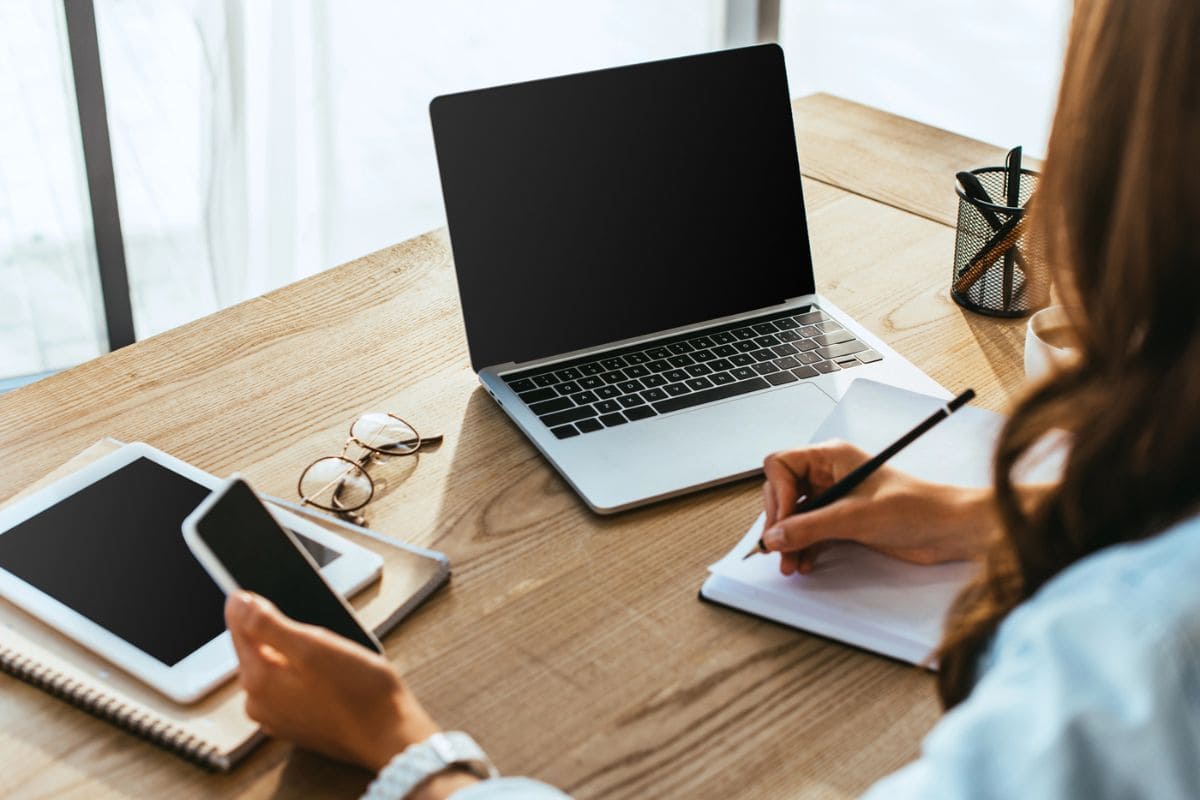Today’s job market is competitive, so while having a great resume and acing the interview process are very important, mastering your job application follow-up email(s) can also impact your chances of landing the role you’re after.
Whether you’re reaching out to a recruiter with a cold email or sending your first follow-up email after a job interview, it may be a struggle to determine what to say. Or, maybe you tend to skip over follow-ups or forget to send those emails altogether. As someone who’s held quite a few work from home and freelancing jobs over the past 10 years, I’ve sent tons of follow-up emails and learned some best practices by trial and error.
This post will walk you through exactly how and when to send follow-up emails for key steps in your job search. I’ll also share some helpful follow-up email templates, email examples (including email subject lines), and call-to-action (CTA) options you can use to improve your chances of getting a positive response.

Why Follow-Up Emails Matter
Sending a follow-up email is more than just good job search etiquette. It’s a way to express your professionalism and gratitude, while also gently nudging for next steps. A well-timed and polite follow-up email can help when you’re searching for a work from home job specifically, since you’ll want to stay top of mind and make sure your skills and experience stand out to hiring managers.
With a work from home job, you often don’t have the luxury of meeting other workers and managers in person and being able to form a connection that way or observe much of their body language. Sending a follow-up email can also help demonstrate your communication skills, especially if the role you’re applying for requires strong written communication.
Additionally, this outreach can help you share additional information or a relevant resource that might have been mentioned during the initial interview.
As a general rule of thumb, you should always personalize a follow-up email. Using the recipient’s name, referencing the company name or discussion topic, and tailoring content to your unique experience is key.
Best Practices For Follow-Up Emails
Before I break down specific scenarios, here are some golden rules to keep in mind for any follow-up email:
- Be Timely: Aim to send your follow-up within 24 to 48 hours of an interview or around a week after applying if you haven’t heard anything back.
- Keep It Concise: Sometimes I struggle with oversharing or writing too much, so be sure to stick to a few short paragraphs since hiring managers are busy.
- Use a Professional Tone: Write clearly and avoid overly casual language. Proofread for grammar and spelling.
- Personalize Your Email: Reference specific details from your interaction to demonstrate your ability to pay attention to important details, as well as your genuine interest.
- Express Gratitude: Whether it’s for reviewing your application or meeting with you, always include a thank-you to express that you’re grateful for their time and the opportunity to apply or interview.
Follow-Up After Submitting an Application
Once you’ve submitted your application, sending a follow-up email can show initiative and that you have a strong interest in the position. If you haven’t heard back about a role you’ve applied for within five to seven business days, it may be a good idea to send a job application follow-up to inquire about the status of your application.
How to Write the Email
- Start by addressing the hiring manager (or HR contact) by name. If the name isn’t listed, take a little time to research it online.
- Mention the position you applied for and when you submitted your application.
- Politely inquire if they require any further information or documents to support your application.
Here’s a Sample Email Template:
Subject: Follow-Up on [Position Name] Application
Dear [Hiring Manager’s Name],
I hope you’re doing well this week. I recently submitted my application for the [job title] role on [date] and wanted to follow up to ensure you received it.
I’m very excited about the opportunity to contribute to [Company’s Name], especially with my experience in [specific skill/field]. If there’s any additional information I can provide or if you need further materials, please don’t hesitate to reach out.
Thank you for your time and consideration. I look forward to the possibility of contributing to your team.
Best regards,
[Your Full Name]
Follow-Up After a Phone or Video Initial Interview
Let’s look at the next follow-up email example. The initial interview is as much about reviewing your qualifications as it is about leaving a lasting impression. Following up after the first interview helps reinforce your interest and can ensure you don’t get lost in the shuffle.
How to Write the Email
- Timeliness is key here, so send this follow-up email within 24 to 48 hours after the job interview.
- Reference a specific moment or topic from the interview that resonated with you to show you were present and engaged.
- Also, remind the recipient of your enthusiasm for the role and company while connecting it to the discussion.
Here’s a Sample Email Template:
Subject: Thank You for the Interview Opportunity
Dear [Interviewer’s Name],
Thank you for taking the time to speak with me about the [Position Name] role at [Company’s Name]. I truly enjoyed learning more about [specific topic discussed, e.g., the team’s innovative projects].
Our conversation reinforced my excitement about the opportunity to contribute to [Company Name] with my skills in [specific strength]. I am particularly eager to bring [specific skill or value you bring] to your team.
Thank you again for this opportunity. Please don’t hesitate to contact me if you need any additional information.
Best regards,
[Your Full Name]
Follow-Up After Assessment or Assignment
Some companies include an assessment or assignment as part of their hiring process, allowing you to demonstrate your skill set. Following up after submitting your work also demonstrates professionalism and serves as a gentle reminder of interest. Plus, it’s so important to send follow-ups at this stage, as you’ve likely already had a few discussions with the recruiter and have begun building a relationship.
How to Write the Email
- Include a concise thank-you note for the opportunity to complete the assignment.
- Provide a brief explanation of your approach or what you learned from the task.
- Present the option to discuss your work further or answer any questions they may have.
Here’s a Sample Email Template:
Subject: Follow-Up After Assessment Submission
Dear [Hiring Manager’s Name],
I wanted to thank you for the opportunity to complete the assignment for the [Position Name] role at [Company’s Name]. I’ve submitted the work [method of submission, e.g., via email or portal] and hope it meets your expectations.
Completing this task furthered my interest in this role, especially as it allowed me to utilize my strengths in [specific skill].
Please feel free to reach out if you have any questions about my work. I look forward to hearing your feedback!
Best regards,
[Your Full Name]

Follow-Up When You Receive an Offer
While it may seem unnecessary to follow up after receiving an offer, expressing gratitude will help solidify a great relationship with your future employer.
How to Write the Email
- Start by thanking the hiring manager for the offer.
- Reiterate your interest and enthusiasm for joining the team.
- If needed, ask any clarifying questions about the offer.
Here’s a Sample Email Template:
Subject: Excited to Join [Company Name]!
Dear [Hiring Manager’s Name],
Thank you so much for offering me the [Position Name] role at [Company’s Name]. I am thrilled about the opportunity to join your team and contribute to [specific company goal or initiative].
If there are any specific details I should review or complete before my start date, please feel free to share. I’m looking forward to starting on [start date] and am eager to hit the ground running.
Thank you again for this incredible opportunity.
Best regards,
[Your Full Name]
Follow-Up After Networking or Informational Interviews
Networking and informational interviews are powerful tools for professional development. You never know who knows who and how certain connections can further your career and open the door to new opportunities.
After a networking or informational interview, it is essential to follow up with the person you spoke with. This not only shows your appreciation for their time and insights, but it also helps to maintain a connection for future opportunities.
How to Write the Email
- Send a thank-you email within 24 to 48 hours of the networking event or informational interview.
- Keep the email simple by expressing your gratitude for their time and insights
- Express your interest in building a positive relationship and offer helpful resources or recommendations.
Here’s a Sample Email Template
Subject: Thank You for Your Time and Insights
Dear [Name],
I want to express my sincere gratitude for taking the time to meet with me yesterday. Our conversation about [specific topic discussed] was extremely valuable and insightful.
I especially appreciated your insights on [specific detail or advice shared]. It has given me a lot to think about, and I am already considering how I can apply this knowledge in my future endeavors.
Your expertise and experience in [industry/profession] are truly impressive, and I feel grateful to have had the opportunity to learn from you. Your willingness to share your knowledge and insights is greatly appreciated.
Please know that I will keep you updated on my progress and any developments related to our conversation. Your guidance and support mean a lot to me, and I am committed to implementing your advice in order to reach my goals.
Best regards,
[Your Full Name]
Common Mistakes to Avoid
Like I said earlier, I’ve made my share of email follow-up mistakes in the past, but it’s often helpful to learn from others’ mistakes. Even the best-intentioned follow-up emails can still miss the mark. So here are some tips on how to avoid these pitfalls to ensure your follow-up leaves a positive impression
- Being Too Pushy: While I’ve struggled with sending follow-up emails consistently (or even at all) in the past, others may have the opposite issue and send too many emails or push too hard. Respect the hiring manager’s time and don’t send multiple emails asking for updates.
- Waiting Too Long: Don’t delay beyond 48 hours to follow up after key milestones. Timing is crucial, so you can even try to draft a follow-up email right after your interview (when it’s top of mind) and schedule it to be sent out the following day.
- Using Generic Language: Avoid stock phrases and templates that don’t feel tailored to the recipient. (The templates shared above are just a starting point, so definitely customize them and make them your own.)
- Skipping Proofreading: Mistakes in spelling or grammar can undermine your professionalism. Run your email through a proofreading tool like Grammarly and even read it out loud to make sure everything looks good and there are no errors.
- Not Showing Appreciation: Always include a sincere “thank you.” Gratitude leaves a lasting impression.
Email Follow-Ups Summary
A well-thought-out follow-up email can make all the difference in your job hunt and boost your chances of landing an offer. By sending thoughtful, timely messages, you’ll stand out as both professional and enthusiastic about the role. Remember to personalize your emails, keep them concise, and always express gratitude, and you’ll be off to a good start.

